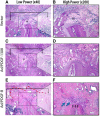Gene therapeutics for periodontal regenerative medicine
- PMID: 16530061
- PMCID: PMC2572757
- DOI: 10.1016/j.cden.2005.12.001
Gene therapeutics for periodontal regenerative medicine
Abstract
There has been significant advancement in the field of periodontal tissue engineering over the past decade for the repair of tooth-supporting structures. Although encouraging results for periodontal tissue regeneration have been found in numerous clinical investigations using recombinant growth factors, limitations exist with topical protein delivery. Newer approaches seek to develop methodologies that optimize growth factor targeting to maximize the therapeutic outcome of periodontal regenerative procedures. Genetic approaches in periodontal tissue engineering show early progress in achieving delivery of growth factor genes, such as platelet-derived growth factor or bone morphogenetic protein, to periodontal lesions. Ongoing investigations in ex vivo and in vivo gene transfer to periodontia seek to examine the extent of the potential effects in stimulating periodontal tissue engineering.
Figures




Similar articles
-
Advanced reconstructive technologies for periodontal tissue repair.Periodontol 2000. 2012 Jun;59(1):185-202. doi: 10.1111/j.1600-0757.2011.00432.x. Periodontol 2000. 2012. PMID: 22507066 Free PMC article. Review.
-
[Periodontal tissue engineering and regeneration].Zhonghua Kou Qiang Yi Xue Za Zhi. 2017 Oct 9;52(10):610-614. doi: 10.3760/cma.j.issn.1002-0098.2017.10.006. Zhonghua Kou Qiang Yi Xue Za Zhi. 2017. PMID: 29972934 Chinese.
-
Cell- and gene-based therapeutic strategies for periodontal regenerative medicine.J Periodontol. 2011 Sep;82(9):1223-37. doi: 10.1902/jop.2011.100710. Epub 2011 Feb 2. J Periodontol. 2011. PMID: 21284553 Free PMC article. Review.
-
Regeneration of tissues of the oral complex: current clinical trends and research advances.J Can Dent Assoc. 2013;79:d1. J Can Dent Assoc. 2013. PMID: 23522126 Review.
-
Regenerative Medicine for Periodontal and Peri-implant Diseases.J Dent Res. 2016 Mar;95(3):255-66. doi: 10.1177/0022034515618887. Epub 2015 Nov 25. J Dent Res. 2016. PMID: 26608580 Free PMC article. Review.
Cited by
-
Stem cells: past, present, and future.Stem Cell Res Ther. 2019 Feb 26;10(1):68. doi: 10.1186/s13287-019-1165-5. Stem Cell Res Ther. 2019. PMID: 30808416 Free PMC article. Review.
-
Structure and mechanical properties of Ank/Ank mutant mouse dental tissues--an animal model for studying periodontal regeneration.Arch Oral Biol. 2009 Jun;54(6):570-6. doi: 10.1016/j.archoralbio.2009.02.011. Epub 2009 Mar 31. Arch Oral Biol. 2009. PMID: 19338977 Free PMC article.
-
Tissue engineering in periodontal regeneration: A brief review.Dent Res J (Isfahan). 2012 Nov;9(6):671-80. Dent Res J (Isfahan). 2012. PMID: 23559940 Free PMC article.
-
Clinical evaluation of autologous platelet rich fibrin in horizontal alveolar bony defects.J Clin Diagn Res. 2014 Nov;8(11):ZC43-7. doi: 10.7860/JCDR/2014/9948.5129. Epub 2014 Nov 20. J Clin Diagn Res. 2014. PMID: 25584315 Free PMC article.
-
Matrices and scaffolds for drug delivery in dental, oral and craniofacial tissue engineering.Adv Drug Deliv Rev. 2007 May 30;59(4-5):308-24. doi: 10.1016/j.addr.2007.03.019. Epub 2007 Apr 18. Adv Drug Deliv Rev. 2007. PMID: 17499385 Free PMC article. Review.
References
-
- Page RC, Offenbacher S, Schroeder HE, et al. Advances in the pathogenesis of periodontitis: summary of developments, clinical implications and future directions. J Periodontol Res 2000. 1997;14:216–48. - PubMed
-
- Williams RC. Periodontal disease. N Engl J Med. 1990;322(6):373–82. - PubMed
-
- Brown LJ, Loe H. Prevalence, extent, severity and progression of periodontal disease. Periodontology 2000. 1993;2:57–71. - PubMed
-
- Kocher T, Konig J, Dzierzon U, et al. Disease progression in periodontally treated and untreated patients: a retrospective study. J Clin Periodontol. 2000;27(11):866–72. - PubMed
-
- Heitz-Mayfield LJ, Schatzle M, Loe H, et al. Clinical course of chronic periodontitis. II. Incidence, characteristics and time of occurrence of the initial periodontal lesion. J Clin Periodontol. 2003;30(10):902–8. - PubMed
Publication types
MeSH terms
Substances
Grants and funding
LinkOut - more resources
Full Text Sources
Other Literature Sources
Medical
Miscellaneous

